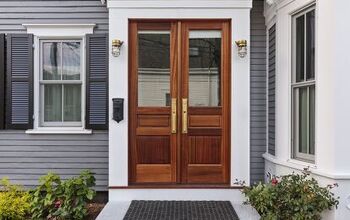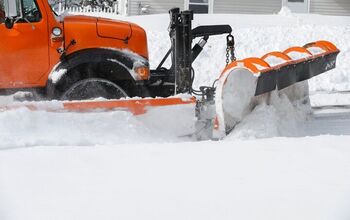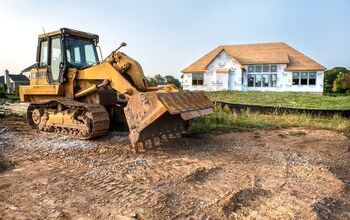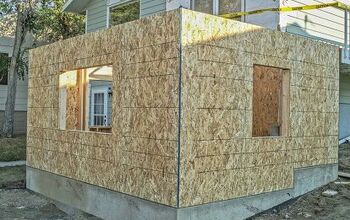How To Cover Above-Ground Tree Roots

Exposed tree roots can pose a tripping hazard in extreme cases, which turns some homeowners off. Others simply cannot stand the visual, as it can throw off the aesthetic and curb appeal in their yard. That’s why you’re not alone if you’ve ever wondered how to cover tree roots that are protruding above ground.
The best way to cover tree roots above ground is to install a raised garden bed on top of them and plant herbs, like basil. You can also cover exposed tree roots with topsoil and mulch to prevent soil erosion and pests. Otherwise, you can kill the surfaced tree roots with herbicides, and then manually remove them when they die.
However, you should hire a professional to remove the exposed tree roots if you have no experience. Doing so requires specific tools, and in some cases, it can be dangerous. Follow along as we explore how to cover tree roots above the ground in your yard.
Why Do Tree Roots Come To The Surface?
Tree roots appear at the surface for many reasons, such as a shallow root system. Some trees have shallow root systems that simply won’t grow deep. You can also cause tree roots to grow shallow if you overcrowd your trees and plant them too close to your house.
This can cause roots to surface, or even worse, grow down toward pipes and sewer lines. You’re more likely to see exposed tree roots in old trees, as the roots can grow thick and run out of space. Sometimes, tree roots appear above ground due to soil compaction, which can smother them.
The same thing can happen if you have unhealthy soil. Tree roots typically surface because their needs aren’t being met, they need oxygen, or they’re overcrowded.
What To Do About Exposed Tree Roots
1. Use Groundcover Plants
Groundcover plants are loved by many, but some homeowners don’t see any practical use for them. However, ground-cover plants come in handy if you want to cover some above-ground tree roots. Creeping thyme and creeping juniper are among the best groundcover plants to cover tree roots above the ground.
Pennsylvania sedge is the easiest groundcover plant to take care of in many ways. It’s durable and works well for tree roots, as roots often pop up in shaded areas. Pennsylvania sedge thrives in shade, and it can even help prevent soil erosion.
Some groundcover plants even work similarly to mulch in that they retain water and prevent soil erosion. They can even withstand cold snaps in many climates, so you don’t typically have to worry about them looking bad during the fall and winter.
2. Install A Raised Garden Bed
Raised garden beds are low-maintenance, durable, visually appealing, and more popular than ever. However, you may not have considered that you can use a raised bed for a practical purpose. What better way to cover your above-ground tree roots than with a raised garden bed?
The key is to cover the roots with a thin layer of topsoil to provide an even base for the raised bed. You may have to sculpt the soil a bit by building it up more in some spots to account for the uneven tree roots. Next, you can either build a raised bed or buy one that is pre-assembled at your local garden center or plant nursery.
You can plant a wide variety of herbs in your raised garden bed, such as thyme, basil, chamomile, and mint. Otherwise, you can fill the raised bed with colorful flowers, like marigolds and pansies. The sky is the limit, as long as you research which plants can thrive in your climate zone.
3. Lay Mulch
Some homeowners believe that the best way to cover above-ground tree roots is to lay mulch, and it’s with good reason. After all, mulch looks great and can protect the ground beneath it from weeds and pests. It’s also a classic sign of yard maintenance, and in some cases, can even i ncrease curb appeal.
Covering your exposed tree roots with mulch can also help protect them from pests and moisture. Wood rot can spread from the exposed roots to the tree itself in some cases, so it’s better to be safe than sorry. You must reapply mulch at least once every 1 to 2 years to ensure it’s still effective and visually appealing.
Inspect your mulch every few months to make sure it’s not crumbly, slimy, or moldy, and that it doesn’t have a sour odor. Replace the mulch if you notice any of those signs, so you can still cover the tree roots and enjoy the benefits.
4. Kill The Roots
Are the exposed tree roots in your yard causing serious problems? Above-ground tree roots can increase the risk of tripping, and they can even negatively impact the grading in your yard. Some people understandably cannot stand this, and they want to kill the roots.
While you can remove above-ground tree roots with a pruning saw, this can be difficult if you have little experience. That’s why some people understandably prefer to use commercial herbicides to kill exposed tree roots. Anything that includes glyphosate should work well to kill the above-ground tree roots in your yard.
Granted, you must still manually remove the tree roots once they’re weak enough. You can hire a tree removal service to get rid of the dead tree roots if needed. It costs between $150 and $800 to remove exposed tree roots, depending on the severity of the problem.
How To Prevent Tree Roots From Surfacing
You can prevent tree roots from surfacing if you plant a tree with deep roots. That includes pine trees, oak trees, walnut trees, and sweetgum trees. Their roots can still surface, but it’s relatively rare, as their roots grow quite deep beneath the ground.
You can also prevent tree roots from surfacing above ground if you cover the ground around the tree with a thick layer of mulch. Reapply the mulch every year or two to retain the benefits and stop the roots from popping up. Some people even install physical root barriers made of metal and plastic to keep the roots underground.
It’s similar to a weed barrier, but a root barrier is more durable, given how strong some tree roots are. Be careful when you water your tree, as overwatering can make tree roots grow shallow instead of deep. Make sure your trees are spaced far apart and away from structures, such as sheds and houses. Otherwise, the roots will likely appear above ground, as they have no space underground.
Summing It Up
You can easily cover above-ground tree roots with groundcover plants, such as creeping thyme and creeping juniper. Otherwise, you can cover the exposed roots with topsoil and place a raised garden bed on top of them. You can also cover the tree roots with mulch to reduce the tripping hazard and prevent wood rot, which could otherwise spread to the rest of the tree.
Related Guides:

Nick Durante is a professional writer with a primary focus on home improvement. When he is not writing about home improvement or taking on projects around the house, he likes to read and create art. He is always looking towards the newest trends in home improvement.
More by Nick Durante














![10 Best Electric Pressure Washers – [2022 Reviews & Guide]](https://cdn-fastly.upgradedhome.com/media/2023/07/31/9070600/10-best-electric-pressure-washers-2022-reviews-guide.jpg?size=350x220)












